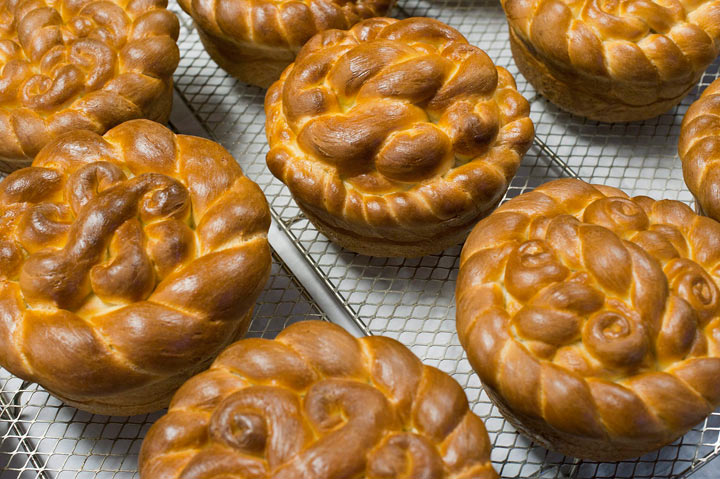Easter would hardly be Easter for many families of European heritage without the centuries-old tradition of rich, often sweet and ornate loaves of homemade Easter bread.

Here are some recipes so that you can try your hand at baking traditional homemade Easter breads.
Lovella’s Paska
Lovella Schellenberg of Abbotsford, B.C., says the aroma of this bread is “just amazing.” The recipe makes enough for four or five loaf pans or you can free-form little twists or use muffin tins, but you have to adjust the baking time and watch the oven closely.
- 30 ml (2 tbsp) active dry yeast
- 5 ml (1 tsp) sugar
- 250 ml (1 cup) warm water
- 1 medium lemon
- 1 medium orange
- 300 ml (1 1/4 cups) milk
- 125 ml (1/2 cup) butter
- 2 large eggs
- 175 ml (3/4 cup) sugar
- 5 ml (1 tsp) salt
- About 1.75 l (7 cups) flour
Paska Icing
- 250 ml (1 cup) soft butter
- 4 egg whites
- 10 ml (2 tsp) vanilla
- Icing sugar (enough to make a soft icing)
- Coloured sugar, for garnish
In a large bowl, combine yeast, sugar and water. Let sit for 10 minutes. (If it doesn’t foam and bubble up, your yeast is old or expired. Start again with new yeast.)
Using a vegetable peeler, thinly slice peel of lemon and orange, avoiding white pith, and place in a blender. Chop lemon and orange, removing seeds. Add chopped fruit to blender.

Get daily National news
In a microwave-safe bowl or in a saucepan on stove, heat milk and butter until butter melts. Add to fruit in blender and puree on high for 2 or 3 minutes.
Add eggs, sugar and salt. Continue to run blender for another minute or two until mixture is very smooth.
Measure milk-citrus and sugar mixture. It should be about 1.125 l (4 1/2 cups). If you have a bit more or less that is fine; you can adjust flour accordingly.
Pour mixture, along with yeast mixture, into a large bowl or bowl of a stand mixer with a dough hook. Add flour, 250 ml (1 cup) at a time, until you have a smooth soft, sticky dough. About 1.75 l (7 cups) of flour should be right, but it will depend on the size of the eggs and of the lemon and orange. With a plastic bowl it is easy to tell when dough has enough flour because it will stop sticking to the side of the bowl, but with a metal bowl, stop mixer often and touch dough before adding more flour. Once it gets close, stop machine and knead in last bit of flour by hand, a little at a time, until dough is smooth. Do not add more than 1.875 (7 1/2 cups) flour.
After kneading dough by hand or with machine for 8 to 10 minutes, transfer to a large bowl, cover with plastic wrap and a tea towel and let rise until doubled. This should take 1 to 1 1/2 hours. Punch it down and let rest for at least 10 minutes or up to another hour.
Spray pans with cooking spray. Divide dough among pans and let rise until doubled in bulk, 1 to 1 1/2 hours.
Meanwhile, heat oven to 180 C (350 F). Bake loaves for about 20 minutes, depending on pan size. Remove from oven and let cool on racks. Wrap loaves and freeze unless eating the same day.
Icing: In a bowl, beat together butter, egg whites, vanilla and icing sugar until light and smooth. Spread on each loaf. Sprinkle with coloured sugar.
Makes 4 or 5 loaves.
Source: Lovella Schellenberg, http://www.mennonitegirlscancook.ca.





Comments